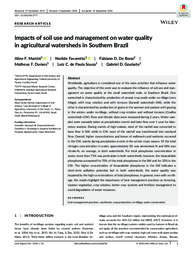Impacts of soil use and management on water quality in agricultural watersheds in Southern Brazil.
Impacts of soil use and management on water quality in agricultural watersheds in Southern Brazil.
Author(s): MARTÍNI, A. F.; FAVARETTO, N.; DE BONA, F. D.; DURÃES, M. F.; SOUZA, L. C. de P.; GOULARTE, G. D.
Summary: Worldwide, agriculture is considered one of the main activities that influence water quality. The objective of this work was to evaluate the influence of soil use and management on water quality at the small watershed scale, in Southern Brazil. One watershed is characterized by production of annual crop seeds under no-tillage (zero tillage), with crop rotation and with terraces (Sarandi watershed?SW), while the other is characterized by production of grains in the summer and pasture with grazing in the winter, under no-tillage, without crop rotation and without terraces (Coxilha watershed?CW). Flow and climatic data were measured during 2 years. Water samples were manually taken at precipitation events and base flow over 1 year for laboratory analysis. During events of high volume, most of the rainfall was converted to base flow in SW, while in CW, most of the rainfall was transformed into overland flow. Overall, higher concentrations and losses of sediments and nutrients occurred in the CW, mainly during precipitation events in the winter crops season. Of the total nitrogen concentration in water, approximately 3% was ammonium-N and 58% was nitrate-N, on average, in both watersheds. For total phosphorus concentration in water, more than 75% was particulate in both watersheds, however, the bioavailable phosphorus accounted for 70% of the total phosphorus in the SW and for 35% in the CW. The higher concentration of bioavailable phosphorus in the SW indicates a short-term pollution potential, but in both watersheds, the water quality was impaired by the high concentrations of total phosphorus. In general, even with no-tillage, the results highlight the importance of best management practices as terracing, riparian vegetation, crop rotation, better crop systems and fertilizer management to avoid degradation of water resources.
Publication year: 2020
Types of publication: Journal article
Unit: Embrapa Wheat
Observation
Some of Embrapa's publications are published as ePub files. To read them, use or download one of the following free software options to your computer or mobile device. Android: Google Play Books; IOS: iBooks; Windows and Linux: Calibre.
Access other publications
Access the Agricultural Research Database (BDPA) to consult Embrapa's full library collection and records.
Visit Embrapa Bookstore to purchase books and other publications sold by Embrapa.

